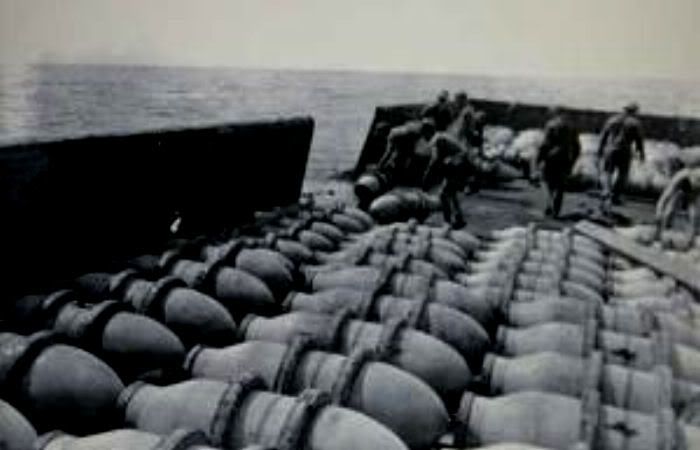All Posts (6434)
Sort by
 FRICKEN DUH ! {rat poison and dead fish are related.}POSTED: 01:30 a.m. HST, Mar 15, 2009LIHUE, Kauai » Niihau residents still are not eating fish months after thousands of dead fish washed ashore.The dead fish appeared in mid-January shortly after the U.S. Fish and Wildlife Service dumped rat poison on nearby Lehua island on behalf of the state Department of Land and Natural Resources.Lehua is less than a mile north of Niihau, a privately owned island with a population of about 100.Niihau residents say they still have not been told whether the rat poison and dead fish are related.In the interim, they have avoided consuming fish, a diet staple.The state Department of Health issued an advisory in February urging residents on the private island not to eat fish from nearby waters."We still don't know what's happening," said Keith Robinson, a member of the family that owns Niihau. "We still don't know whether it is safe to eat fish, and we are still looking for an official statement."Robinson added that there are reportedly about a dozen monk seals who used to regularly visit the island and have recently "gone missing," while others appear "extremely sick."He said, however, that residents have not had a food shortage and have not been in serious need of food and supplies. A report posted on the Association of Hawaiian Civic Clubs Web site erroneously reported the island needed food, he said.Robinson said the island's supply barge arrived last weekend, and there was no such shortage of food or supplies."The supply line of food to Niihau is open, but the bottom line is the people have not been able to go back to eating fish. The Department of Health has not given us clearance," he added.Janice Okubo, Department of Health spokeswoman, said the department never actually issued a direct ban for eating fish on Niihau."It was an advisory; people need to use their own common sense and judgment," she said, when asked whether Niihau fishing could resume. "For us to do a ban and to enforce it, we would have to have really strong evidence."Ilei Beniamina, a part-time Niihau resident who is an assistant professor in counseling at Kauai Community College, believes residents are not getting enough vital nutrients that the fish once provided, such as protein and calcium."Our people depend on the ocean. The ocean is their Costco," said Beniamina.LIHUE, Kauai » Niihau residents still are not eating fish months after thousands of dead fish washed ashore.The dead fish appeared in mid-January shortly after the U.S. Fish and Wildlife Service dumped rat poison on nearby Lehua island on behalf of the state Department of Land and Natural Resources.Lehua is less than a mile north of Niihau, a privately owned island with a population of about 100.Niihau residents say they still have not been told whether the rat poison and dead fish are related.In the interim, they have avoided consuming fish, a diet staple.The state Department of Health issued an advisory in February urging residents on the private island not to eat fish from nearby waters."We still don't know what's happening," said Keith Robinson, a member of the family that owns Niihau. "We still don't know whether it is safe to eat fish, and we are still looking for an official statement."Robinson added that there are reportedly about a dozen monk seals who used to regularly visit the island and have recently "gone missing," while others appear "extremely sick."He said, however, that residents have not had a food shortage and have not been in serious need of food and supplies. A report posted on the Association of Hawaiian Civic Clubs Web site erroneously reported the island needed food, he said.Robinson said the island's supply barge arrived last weekend, and there was no such shortage of food or supplies."The supply line of food to Niihau is open, but the bottom line is the people have not been able to go back to eating fish. The Department of Health has not given us clearance," he added.Janice Okubo, Department of Health spokeswoman, said the department never actually issued a direct ban for eating fish on Niihau."It was an advisory; people need to use their own common sense and judgment," she said, when asked whether Niihau fishing could resume. "For us to do a ban and to enforce it, we would have to have really strong evidence."Ilei Beniamina, a part-time Niihau resident who is an assistant professor in counseling at Kauai Community College, believes residents are not getting enough vital nutrients that the fish once provided, such as protein and calcium."Our people depend on the ocean. The ocean is their Costco," said Beniamina
FRICKEN DUH ! {rat poison and dead fish are related.}POSTED: 01:30 a.m. HST, Mar 15, 2009LIHUE, Kauai » Niihau residents still are not eating fish months after thousands of dead fish washed ashore.The dead fish appeared in mid-January shortly after the U.S. Fish and Wildlife Service dumped rat poison on nearby Lehua island on behalf of the state Department of Land and Natural Resources.Lehua is less than a mile north of Niihau, a privately owned island with a population of about 100.Niihau residents say they still have not been told whether the rat poison and dead fish are related.In the interim, they have avoided consuming fish, a diet staple.The state Department of Health issued an advisory in February urging residents on the private island not to eat fish from nearby waters."We still don't know what's happening," said Keith Robinson, a member of the family that owns Niihau. "We still don't know whether it is safe to eat fish, and we are still looking for an official statement."Robinson added that there are reportedly about a dozen monk seals who used to regularly visit the island and have recently "gone missing," while others appear "extremely sick."He said, however, that residents have not had a food shortage and have not been in serious need of food and supplies. A report posted on the Association of Hawaiian Civic Clubs Web site erroneously reported the island needed food, he said.Robinson said the island's supply barge arrived last weekend, and there was no such shortage of food or supplies."The supply line of food to Niihau is open, but the bottom line is the people have not been able to go back to eating fish. The Department of Health has not given us clearance," he added.Janice Okubo, Department of Health spokeswoman, said the department never actually issued a direct ban for eating fish on Niihau."It was an advisory; people need to use their own common sense and judgment," she said, when asked whether Niihau fishing could resume. "For us to do a ban and to enforce it, we would have to have really strong evidence."Ilei Beniamina, a part-time Niihau resident who is an assistant professor in counseling at Kauai Community College, believes residents are not getting enough vital nutrients that the fish once provided, such as protein and calcium."Our people depend on the ocean. The ocean is their Costco," said Beniamina.LIHUE, Kauai » Niihau residents still are not eating fish months after thousands of dead fish washed ashore.The dead fish appeared in mid-January shortly after the U.S. Fish and Wildlife Service dumped rat poison on nearby Lehua island on behalf of the state Department of Land and Natural Resources.Lehua is less than a mile north of Niihau, a privately owned island with a population of about 100.Niihau residents say they still have not been told whether the rat poison and dead fish are related.In the interim, they have avoided consuming fish, a diet staple.The state Department of Health issued an advisory in February urging residents on the private island not to eat fish from nearby waters."We still don't know what's happening," said Keith Robinson, a member of the family that owns Niihau. "We still don't know whether it is safe to eat fish, and we are still looking for an official statement."Robinson added that there are reportedly about a dozen monk seals who used to regularly visit the island and have recently "gone missing," while others appear "extremely sick."He said, however, that residents have not had a food shortage and have not been in serious need of food and supplies. A report posted on the Association of Hawaiian Civic Clubs Web site erroneously reported the island needed food, he said.Robinson said the island's supply barge arrived last weekend, and there was no such shortage of food or supplies."The supply line of food to Niihau is open, but the bottom line is the people have not been able to go back to eating fish. The Department of Health has not given us clearance," he added.Janice Okubo, Department of Health spokeswoman, said the department never actually issued a direct ban for eating fish on Niihau."It was an advisory; people need to use their own common sense and judgment," she said, when asked whether Niihau fishing could resume. "For us to do a ban and to enforce it, we would have to have really strong evidence."Ilei Beniamina, a part-time Niihau resident who is an assistant professor in counseling at Kauai Community College, believes residents are not getting enough vital nutrients that the fish once provided, such as protein and calcium."Our people depend on the ocean. The ocean is their Costco," said Beniamina

 Munitions dump eludes undersea huntersChemical weapons were disposed of off Oahu 50 years agoBy Gregg K. Kakesako
Munitions dump eludes undersea huntersChemical weapons were disposed of off Oahu 50 years agoBy Gregg K. Kakesako Canisters like these are the subject of a deep-water hunt south of Pearl Harbor by the University of Hawaii's School of Ocean and Earth Science and Technology.POSTED: 01:30 a.m. HST, Mar 12, 2009After 12 dives six miles south of Pearl Harbor, University of Hawaii and Army researchers using deep-diving submersibles and remote underwater drones still have not located the main site of chemical munitions believed to have been dumped there during and after World War II.They have found "numerous munitions of varying types, mostly conventional," said J.C. King, assistant for munitions and chemical matters in the office of the deputy assistant secretary of the Army for environment, safety and occupational health, in an e-mail yesterday.He said of munitions recorded by high-definition video cameras are "multipurpose (conventional or chemical)."The Army has contracted the Hawaii Undersea Research Laboratory submersibles Pisces IV and V to explore the ocean bottom in an area dubbed "Hawaii-05" by the Army. The 2 1/2 -week project will end March 19.Seventeen dives by the submersible and an additional six by remotely operated vehicles are planned.The purpose of the $3 million Army project is to determine the risks of some 600 tons of chemical weapons dumped there. The Army plans to test water and sediment samples taken from the muddy bottom.King said, "The goal is to assess the impact of the munitions on the ocean environment and the impact of the ocean environment on munitions."The Pearl Harbor site is one of three off Oahu where the Army dumped 2,558 tons of chemical agents, including blister agents lewisite and mustard gas and blood agents cyanogen chloride and hydrogen cyanide. The practice of ocean dumping was banned in 1972.The largest dump is reported to be in area 10 miles west of the Waianae Coast.The Army has said it believes 16,000 M47-A2 bombs containing 598 tons of mustard gas were dumped at "Hawaii-05" around Oct. 1, 1944. Each chemical bomb weighs 100 pounds and is nearly 32 inches long.Most of the dives are at about 1,500 feet.King has been a passenger on at least two of the dives."As expected," King said, "the munitions are meters apart and generally of the same type (e.g., a series of .50-caliber boxes, a series of projectiles). This is expected because ship loads would have been from storage, and we generally store and transport these same munition types together."
Canisters like these are the subject of a deep-water hunt south of Pearl Harbor by the University of Hawaii's School of Ocean and Earth Science and Technology.POSTED: 01:30 a.m. HST, Mar 12, 2009After 12 dives six miles south of Pearl Harbor, University of Hawaii and Army researchers using deep-diving submersibles and remote underwater drones still have not located the main site of chemical munitions believed to have been dumped there during and after World War II.They have found "numerous munitions of varying types, mostly conventional," said J.C. King, assistant for munitions and chemical matters in the office of the deputy assistant secretary of the Army for environment, safety and occupational health, in an e-mail yesterday.He said of munitions recorded by high-definition video cameras are "multipurpose (conventional or chemical)."The Army has contracted the Hawaii Undersea Research Laboratory submersibles Pisces IV and V to explore the ocean bottom in an area dubbed "Hawaii-05" by the Army. The 2 1/2 -week project will end March 19.Seventeen dives by the submersible and an additional six by remotely operated vehicles are planned.The purpose of the $3 million Army project is to determine the risks of some 600 tons of chemical weapons dumped there. The Army plans to test water and sediment samples taken from the muddy bottom.King said, "The goal is to assess the impact of the munitions on the ocean environment and the impact of the ocean environment on munitions."The Pearl Harbor site is one of three off Oahu where the Army dumped 2,558 tons of chemical agents, including blister agents lewisite and mustard gas and blood agents cyanogen chloride and hydrogen cyanide. The practice of ocean dumping was banned in 1972.The largest dump is reported to be in area 10 miles west of the Waianae Coast.The Army has said it believes 16,000 M47-A2 bombs containing 598 tons of mustard gas were dumped at "Hawaii-05" around Oct. 1, 1944. Each chemical bomb weighs 100 pounds and is nearly 32 inches long.Most of the dives are at about 1,500 feet.King has been a passenger on at least two of the dives."As expected," King said, "the munitions are meters apart and generally of the same type (e.g., a series of .50-caliber boxes, a series of projectiles). This is expected because ship loads would have been from storage, and we generally store and transport these same munition types together." http://www.starbulletin.com/news/20090312_Munitions_dump_eludes_undersea_hunters.html
http://www.starbulletin.com/news/20090312_Munitions_dump_eludes_undersea_hunters.html
http://www.facebook.com/profile.php?id=1198578566
huissss<333
